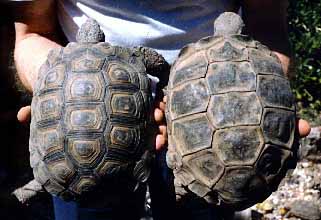
Reasons not to release Turtles into the wild
What types of turtles are people releasing into the wild?
We have found mostly red eared sliders, map turtles, and cooters, but people who are willing to sentence their turtles to a more immediate and more painful death also release snapping turtles and tortoises as well as terrapins
What is a red eared slider?

A red eared slider is an aquatic turtle that is native to tropical and subtropical waters, not Canada!! They have a life span of up to and sometimes beyond 25 years, they can get more than a foot long. Does this sound like a good pet for a child? We don't think so, these animals are messy, tedious to take care of, and have a very nasty bite. With the problems we experience from our rescue turtles, vet bills are also quite expensive.
What do they look like?
A red eared slider is most easily recognised by the red markings that runs down the sides of their heads. They are semi-aquatic turtles, so they do have webbed feet, and long claws on the males.Sliders in general have rounded jaws that enable them to catch fish and dig in the mud for food.
What is a Mississippi map turtle?

A map turtle is one of the most beautiful species of aquatic turtles, they are very shy, and like low noise.
What do they look like?
They are very beuatiful, they have a flat lower jaw that enables them to crunch shells, and the flutes on their shells are distinct and jagged.
What type of care do they need?
This is where it gets difficult, Mississippi map turtles need very clean water, they won't eat and will become depressed if they do not, they also need fed quite differently than sliders, they will need a cuttle bone to chew on, and will eat smelts, snails, salmon and stewing beef as well as an assortment of worms. For these reasons it is highly unlikely that a map turtle would survive out in the wild anywhere in B.C or Canada fo that matter.Check out a care sheet here
What is a totrtoise?

A tortoise is a mainly land species of turtle, there is no way they could survive in the wilds of Canada, they require very elaborate conditions to survive, as you can read on a care sheet
Snapping turtles
some information about snapping turtles can be found here
Turtle Homes information on snapping turtles
What we are trying to do
We are trying to educate people of the dangers of releasing turtles into the wild, both to them, and to the animals and area in into which they are being released.
What are we doing about the problem?
HomeFinders has recently started a turtle rescue program in which we go to the lakes in our area and salvage the worst turtles we find, the Rainforest Retile refuge Society
is currently doing a study on how many turtles are in our area, but due to the overabundance of turtles they already have,they are unable to take in any more red eared sliders.
What happens to the turtles that aren't in such bad shape?
Sadley, due to our lack of funding, we are only able to take in the turtles that are emergency cases, and that leaves the ones that are still surviving to fend for themselves until they too are dying and wasting away. We know this seems redundant, but it is all that we can do at this time.
What can I do to help?
We are asking the public to help turtle awareness, report anyone that you know that is dumping turtles or other exotic wildlife to the number above, and please, do not dump your turtle.
You can also sponsor a turtle through us, and aid us to give it the proper care it needs, until we find it a suitable home with people who are aware of the responsibility of adopting these animals, to do this, please send mail to adoptaturtle@homefinders.zzn.com
Find out how to sponsor other animals Click Here!! CURRENTLY UNDER CONSTRUCTION - PLEASE CHECK BACK SOON OR JOIN HOMEFINDERS MAILING LIST AT groups.yahoo.com/group/homefinderscanada TO BE NOTIFIED OF SITE UPDATES.
Back to......
Back to Homefinders
Back to the dog zone
Reptile Refuge Turtle Study